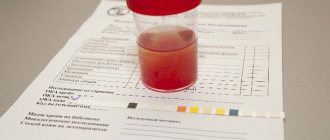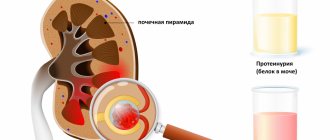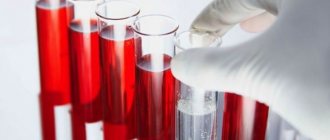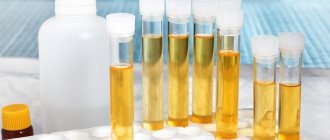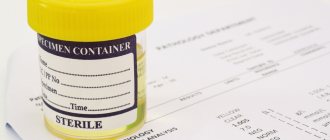In the article you will read what indicators are included in a general urine analysis, what are the reference intervals for these indicators, what is the norm of leukocytes and red blood cells in the urine, how much protein and sugar can be in the urine, what epithelial cells are found in the analysis.
The information was prepared by doctors from CIR laboratories and clinics.
A general clinical examination of urine (general urinalysis, OAM) includes the determination of physical properties, chemical composition and microscopic examination of sediment.
Urine color
The color of urine normally ranges from light yellow to deep yellow and is due to the pigments it contains (urochrome A, urochrome B, uroethrin, uroresin, etc.).
Reference values:
| Children | Various shades of yellow |
| Men | Various shades of yellow |
| Women | Various shades of yellow |
Interpretation
The intensity of the color of urine depends on the amount of urine excreted and its specific gravity. Rich yellow urine is usually concentrated, excreted in small quantities and has a high specific gravity. Very light urine is slightly concentrated, has a low specific gravity and is excreted in large quantities.
Discoloration may be the result of a pathological process in the urinary system, the effects of dietary components, or medications taken.
Norm and deviations
The level of mucus in urine is determined using a clinical urine test. The laboratory specialist performing this study evaluates the concentration of mucous contents on a scale of 4 plus. A normal level of mucus in urine is indicated by only one plus (+). The maximum index of epithelial secretion in urine is a clinical result of four pluses (++++). In this case, the patient’s urine resembles a homogeneous mixture in the form of thick jelly.
Two and three pluses indicate a violation of the biological composition of urine, and also act as a symptom of one or several diseases of the body. A urologist, nephrologist or therapist is responsible for interpreting the final results of laboratory tests.
The appearance of excess mucus in urine requires additional diagnostics. A hardware examination of the pelvis and organs of the urinary system allows us to detect a pathological factor that provokes hyperfunction of epithelial cells in the synthesis of mucous contents.
Transparency (turbidity)
Normal urine is clear. Cloudiness of urine can be the result of the presence of red blood cells, leukocytes, epithelium, bacteria, fat droplets, precipitation of salts, pH, mucus, urine storage temperature (low temperature promotes the precipitation of salts).
In cases where the urine is cloudy, you should find out whether it is immediately cloudy, or whether this cloudiness occurs some time after standing.
| Children | Full transparency |
| Men | Full transparency |
| Women | Full transparency |
Specific gravity of urine (g/l)
In a healthy person, it can fluctuate over a fairly wide range throughout the day, which is associated with periodic food intake and loss of fluid through sweat and exhaled air.
| Children under 1 month | 1002-1020 |
| Children 2 – 12 months | 1002-1030 |
| Children 1 year - 6 years | 1002-1030 |
| Children 7 - 14 years old | 1001-1040 |
| Children 15 - 18 years old | 1001-1030 |
| Men | 1010-1025 |
| Women | 1010-1025 |
Interpretation
The specific gravity of urine depends on the amount of substances dissolved in it: urea, uric acid, creatinine, salts.
- A decrease in the specific gravity of urine (hyposthenuria) to 1005-1010 g/l indicates a decrease in the concentrating ability of the kidneys, an increase in the amount of urine excreted, and drinking plenty of fluids.
- An increase in the specific gravity of urine (hypersthenuria) of more than 1030 g/l is observed with a decrease in the amount of urine excreted, in patients with acute glomerulonephritis, systemic diseases, and cardiovascular failure; it may be associated with the appearance or increase of edema, large loss of fluid (vomiting, diarrhea ), toxicosis of pregnant women.
Treatment methods
Mucus in the urine in women (the reasons for the manifestation of this symptom can be caused by prolonged hypothermia of the body) is one of the first signs of a painful condition of the kidneys, bladder walls or urethral canal. To normalize the biochemical composition of urine, drug therapy, cytostatics and chemical drugs, surgical treatment, and folk recipes are used.
Medications
Inflammatory diseases of the urinary system require the use of antibacterial, diuretic, and antispasmodic drugs with a wide spectrum of action.
Canephron N
Canephron N is a plant-based anti-inflammatory and diuretic agent. This medication contains extracts of centaury, rosemary and lovage. The drug is available in the form of orange tablets coated with a protective layer.
Canephron N is prescribed to women in whom the appearance of mucus in the urine is caused by the following diseases:
- glomerulonephritis;
- cystitis;
- pyelonephritis;
- interstitial type nephritis.
Canephron N prevents the appearance of urinary stones, and also provides prevention of infectious inflammation in the postoperative period after their surgical or laser removal. The dosage regimen for this medication involves taking 2 tablets 3 times a day with a therapeutic course duration of 4 weeks. The average cost of the drug Canephron N is from 504 to 587 rubles. for 60 tab.
Nitroxoline
Mucus in the urine of women (the causes of this symptom are determined by the doctor before starting the therapeutic process) is just a symptom of an underlying disease of the urinary system. The use of Nitroxoline allows for comprehensive antibacterial sanitation of the kidneys, ureter, urethral canal and bladder. This drug is a specific uroantiseptic with a broad spectrum of action.
Nitroxoline tablets are indicated for use by women with high levels of mucus in the urine and who have the following body diseases:
- urethritis;
- pyelonephritis;
- cystitis.
The drug Nitroxoline is used to prevent inflammatory and infectious processes that may occur after surgery on the organs of the urinary system. The active ingredient of this medication is the antibacterial component nitroxoline at a concentration of 50 mg. The active substance of this drug is effective against most strains of Staphylococcus aureus, enterobacterial infection, streptococcus, enterococcus, and mycobacteria.
The antibacterial agent Nitroxoline is taken in a dosage of 4 tablets 3 times a day. Duration of treatment is from 10 to 14 days. Patients with chronic pyelonephritis with signs of recurrent inflammation are prescribed long courses of treatment, the duration of which ranges from 1 to 3 months. The average cost of uroantiseptic Nitroxolinot is 83 to 283 rubles. for 50 tab.
Erythromycin
Erythromycin is a broad-spectrum antibacterial agent from the pharmacological group of macrolides. This drug is available in the form of white tablets coated with a layer of enteric coating. This medication contains the chemical erythromycin in a dosage of 100, 250 or 500 mg.
The antibiotic Erythromycin is prescribed for a course of use in women whose mucus in the urine is caused by infectious and inflammatory processes in the organs of the urinary system. The dosage regimen for Erythromycin requires taking 250 mg of this medication up to 4 times a day. The duration of therapy is 2 weeks. The average cost of this antibacterial agent is 57 rubles. for 10 tablets
Surgery
Surgery is indicated for women who have mucus in their urine caused by a tumor in the kidneys, bladder or ureter. Surgical treatment is carried out for benign and cancerous tumors.
In particularly severe cases, complete removal of the affected kidney or bladder is possible. Surgical operations of this type are performed under general anesthesia in the inpatient department of nephrology or oncology. The average period of postoperative rehabilitation ranges from 2 to 6 months.
Laser therapy
Patients with urolithiasis, which provokes increased mucus secretion, are advised to undergo a course of laser stone crushing. Foreign stones localized in the ureter, kidneys, and bladder are crushed using a laser. Urine stones are crushed to the state of sand or the finest fraction possible, and then removed from the body naturally during the process of urination.
The effectiveness of this method increases with the simultaneous use of diuretics, which accelerate the process of cleansing the kidneys and bladder of foreign stones. The average cost of laser stone crushing is 55,000 rubles.
Folk remedies
There are several folk recipes that allow you to cleanse the urinary system of mucus, relieve inflammation and swelling of tissues.
Bearberry decoction
The preparation of this anti-inflammatory drug requires compliance with the following algorithm of actions:
- Take 1 cup of dried bearberry.
- Pour 0.5 liters of cold water over the plant material.
- Boil the future medicine in a water bath for 15 minutes.
The finished product is taken 100 ml 3 times a day for 20 minutes. before meals. A decoction based on bearberry stimulates kidney function, relieves inflammation, and has a moderate diuretic effect.
Berry juice
To independently prepare berry juice for diseases of the genitourinary system, you must perform the following steps:
- Take 1 kg of fresh lingonberries.
- Pour this ingredient into 250 g of granulated sugar.
- Add 5 liters of cold water.
- Grind the lingonberries to a pulp, mixing them with the rest of the ingredients of the folk remedy.
- Boil the resulting mass over low heat for 2 minutes.
A glass of berry smoothie with fresh fruits, shallow depth of field
Berry juice based on lingonberries, take 2 tbsp. l. 3 times a day. The duration of the therapeutic course is not limited by time. This remedy relieves inflammation of the kidney tissue, bladder walls, and improves the functions of all organs of the urinary system.
Urine reaction (pH)
The pH of urine in a healthy person on a mixed diet is acidic or slightly acidic.
| Children under 1 month | 5,4 — 5,9 |
| Children 2 – 12 months | 6,9 — 7,8 |
| Children 1 year - 6 years | 5,0 — 7,0 |
| Children 7 - 14 years old | 4,7 — 7,5 |
| Children 15 - 18 years old | 4,7 — 7,5 |
| Men | 5,3 — 6,5 |
| Women | 5,3 — 6,5 |
Interpretation
The urine reaction may vary depending on the nature of the food. The predominance of animal proteins in the diet leads to a sharply acidic reaction; with a vegetable diet, the urine reaction is alkaline.
- An acidic urine reaction is observed with fevers of various origins, diabetes mellitus in the stage of decompensation, fasting, and renal failure.
- An alkaline reaction of urine is characteristic of cystitis, pyelonephritis, significant hematuria, after vomiting, diarrhea, and drinking alkaline mineral water.
Vesiculitis: diagnosis
There are several main methods for diagnosing vesiculitis:
- Rectal examination, which is basic for diagnosis.
- The secretion of the seminal vesicles is examined by catheterization.
- Vesiculography, considered traditional for diagnosis.
- Ultrasonography.
- Computed tomography and nuclear magnetic resonance are modern diagnostic methods that give a clearer picture of changes in the body. This method is much more expensive, and often the diagnosis can be made without resorting to expensive studies.
The following tests are required:
- general blood and urine analysis;
- sperm analysis.
Mandatory semen analysis
Chemical examination of urine
Currently, chemical testing of urine is carried out on automatic analyzers using the dry chemistry method.
Chemical testing includes determination in urine:
- squirrel
- glucose
- ketone bodies
Protein in urine, normal protein in urine
Normal urine contains a very small amount of protein (less than 0.002 g/l), which is not detected by qualitative samples, so it is considered that there is no protein in the urine. The appearance of protein in the urine is called proteinuria.
| Children under 1 month | absent |
| Children 2 – 12 months | absent |
| Children 1 year - 6 years | absent |
| Children 7 - 14 years old | absent |
| Children 15 - 18 years old | absent |
| Men | < 0,1 |
| Women | < 0,1 |
Interpretation
Physiological proteinuria includes cases of temporary appearance of protein in the urine that are not associated with diseases. Such proteinuria is possible in healthy people after eating a large amount of protein-rich food, after severe physical stress, emotional experiences, and epileptic seizures.
Functional proteinuria associated with hemodynamic stress can occur in children with fever, emotional stress, congestive heart failure or hypertension, or after cooling.
Pathological proteinuria is divided into renal (prerenal) and extrarenal (postrenal):
- Extrarenal proteinuria is caused by an admixture of protein secreted by the urinary tract and genitals; they are observed in cystitis, pyelitis, prostatitis, urethritis, vulvovaginitis. Such proteinuria rarely exceeds 1 g/l (except for cases of severe pyuria - detection of a large number of leukocytes in the urine).
- Renal proteinuria is most often associated with acute and chronic glomerulonephritis and pyelonephritis, nephropathy in pregnancy, febrile conditions, severe chronic heart failure, renal amyloidosis, lipoid nephrosis, renal tuberculosis, hemorrhagic fevers, hemorrhagic vasculitis, hypertension.
False-positive results when using test strips can be caused by severe hematuria, increased density (more than 1.025) and pH (above 8.0) of urine.
Determination of glucose (sugar). Normal level of glucose in urine.
Also, urine normally contains traces of glucose not exceeding 0.02%, which, like protein, is not detected by ordinary qualitative tests.
| Children under 1 month | absent |
| Children 2 – 12 months | absent |
| Children 1 year - 6 years | absent |
| Children 7 - 14 years old | absent |
| Children 15 - 18 years old | absent |
| Men | 0 – 1,6 |
| Women | 0 – 1,6 |
Interpretation
The appearance of glucose in the urine (glucosuria) can be physiological and pathological.
- Physiological glucosuria is observed when eating large amounts of carbohydrates (alimentary glucosuria), after emotional stress (emotional glucosuria), after taking certain medications (caffeine, glucocorticoids), and in case of poisoning with morphine, chloroform, phosphorus.
- Pathological glucosuria can be of pancreatic origin (diabetes mellitus), thyroid (hyperthyroidism), pituitary (Ishchenko-Cushing syndrome), hepatic (bronze diabetes). To correctly assess glucosuria, it is necessary to determine the amount of sugar in daily urine, which is especially important in patients with diabetes.
Ketone bodies in urine
Ketone bodies (acetone, acetoacetic acid, (B-hydroxybutyric acid)) can sometimes be detected in the urine of a healthy person with a very small intake of carbohydrates and a large amount of fats and proteins.
| Children under 1 month | none |
| Children 2 – 12 months | none |
| Children 1 year - 6 years | none |
| Children 7 - 14 years old | none |
| Children 15 - 18 years old | none |
| Men | none |
| Women | none |
Interpretation
Ketone bodies appear in the urine during fasting, alcohol intoxication, diabetes mellitus, in children with vomiting and diarrhea, neuro-arthritic diathesis, as well as during severe infectious processes accompanied by a prolonged increase in temperature.
Causes of vesiculitis
The causes of vesiculitis in men are infectious and stagnant.
Vesiculitis in men may appear due to the following factors:
- interruption of sexual intercourse;
- masturbation;
- no regularity of sexual activity;
- abstinence;
- defective ejaculations;
- alcohol and nicotine;
- hypothermia often occurs;
- sedentary lifestyle;
- expansion of hemorrhoidal veins and other pelvic inflammations.
